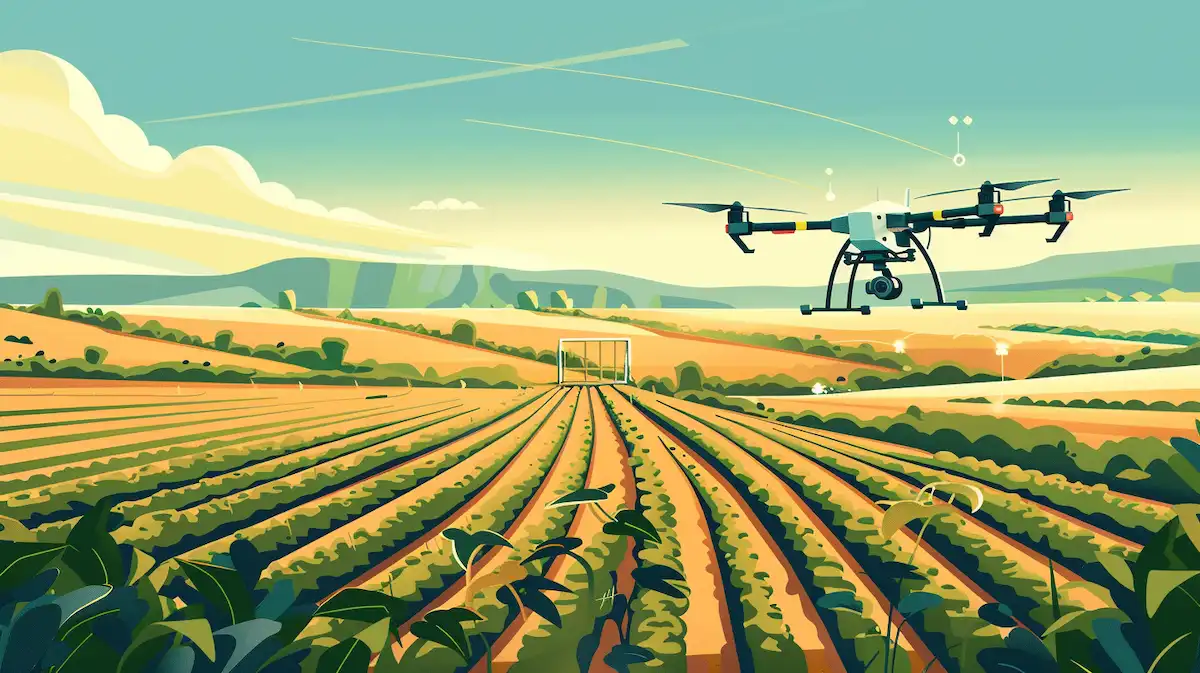スマート農業を英語で説明・紹介するための基本情報と、英会話に役立つ表現をシンプルでわかりやすい英語で紹介します。
英会話ダイアローグ・関連情報・10の質問を通して、スマート農業に関する英語表現を学びます。
英語
英会話ダイアローグを読む前に知っておくと良い前提知識と情報は以下の通りです。
- スマート農業とは
- スマート農業は、農業の効率、生産性、持続可能性を向上させるために、先端技術を利用する農業手法
- ドローン、自動化トラクター、IoTセンサー、ロボットなどの技術が含まれる
- 使用される技術
- ドローン: 作物の健康状態をモニターし、病気や害虫、水ストレスを早期に発見する
- 自動化トラクター: GPSとAIを使用して、耕作、植え付け、収穫を高精度で行う
- IoTセンサー: 土壌の湿度、温度、栄養素レベルをリアルタイムで監視
- ロボット: 特定の作物を迅速かつ効率的に収穫
- 導入事例
- 小規模農場: IoTを使用して土壌と天候を監視し、収穫量と品質を向上させる
- 中規模から大規模農場: ドローンを使用して害虫を早期に発見し、肥料を均一に散布
- コミュニティ努力: 農家が協力してスマート機器を共有し、コストを削減
- 政府の支援
- 日本政府は、スマート農業技術の導入を支援するために、補助金や助成金を提供
- 研究開発を支援し、これらの技術をより利用しやすくしている
- スマート農業法も制定され、技術の利用と開発を促進するための財政的支援とインセンティブが提供されている
- 課題
- 高い初期コスト: 技術の購入と保守にかかる費用が高い
- 技術的な専門知識: 新しい技術を効果的に使用するためには、農家が新しいスキルと知識を習得する必要がある
- データ管理: 大量のデータを効果的に管理し、利用するためのシステムが必要
- インフラ要件: 安定したインターネット接続と電力供給が必要
- 環境および社会的懸念: 高度な機器の生産と廃棄が環境に与える影響、そして技術を利用できない小規模農家が取り残されるリスク
2人がスマート農業について話しています。
農業の効率・生産性向上のために、ドローン、自動化トラクター、IoTセンサーなどの先端技術の活用、導入事例、政府の支援、法制度、課題などを話題にしています。
会話 / dialogue

Hey Key, I’ve been really interested in smart agriculture lately. I heard it’s becoming quite a big deal in Japan.

Absolutely, Mack. Smart agriculture is transforming the way we farm. It uses technology like drones, automated tractors, and IoT sensors to make farming more efficient.

That’s fascinating. How exactly do these technologies help?

Well, for instance, drones can monitor crops by taking detailed images. They help detect diseases, pests, and water stress early, so farmers can take action before it’s too late.

That sounds incredibly useful. What about automated machinery?

Automated tractors and harvesters use GPS and AI to perform tasks like plowing, planting, and harvesting with high precision. This reduces the need for manual labor and increases efficiency.

What about smaller farms? Can they benefit from smart agriculture too?

Definitely. Small farms can use IoT sensors to monitor soil moisture and weather conditions. This helps them optimize irrigation and fertilization, leading to better yields and quality.

Interesting. Are there any examples of how communities are adopting this?

Yes, in some areas, farmers are collaborating to share smart equipment. This reduces costs and allows them to collectively benefit from the technology.

How is the Japanese government supporting this transition?

The government provides grants and subsidies to help farmers adopt smart technologies. They also support research and development to make these technologies more accessible and effective.

I’ve heard about the Smart Agriculture Law. What’s that about?

The Smart Agriculture Law promotes the use and development of smart farming technologies. It provides financial support and incentives for farmers to adopt these technologies.

Are there any challenges with implementing smart agriculture?

Yes, there are several. The high initial costs of technology, the need for technical expertise and training, data management, and infrastructure requirements like reliable internet and power are major challenges.

And what about the environmental and social aspects?

There’s a concern about the environmental impact of producing and disposing of high-tech equipment. Also, there’s a risk that small-scale farmers might be left behind if they can’t afford these technologies.

It sounds like there’s a lot to consider, but the potential benefits are huge.

Absolutely. If we can address these challenges, smart agriculture can greatly improve productivity and sustainability in farming.
関連情報 / related information
「スマート農業」について、理解を深めるための「英語での関連情報」です。
スマート農業

What is Smart Agriculture?
Smart agriculture uses modern technology to improve farming. It helps farmers be more efficient, increase crop yields, and make farming more sustainable. Technologies like drones, automated tractors, IoT sensors, and robots are commonly used in smart agriculture.
Technologies Used
Drones are used to take detailed images of crops. These images help farmers detect problems like diseases, pests, and water stress early. Automated tractors use GPS and AI to perform tasks such as plowing, planting, and harvesting with high precision. IoT sensors are placed in fields to monitor soil moisture, temperature, and nutrient levels in real-time. Robots can quickly and efficiently harvest fruits and vegetables.
Examples of Use
Smart agriculture is used in different ways. Small farms use IoT to monitor soil and weather, which leads to better crop yields and quality. Medium to large farms use drones to detect pests early and apply fertilizers evenly. In some communities, farmers share smart equipment to reduce costs and benefit from the technology together.
Government Support
The Japanese government supports smart agriculture by providing grants and subsidies. They help farmers adopt new technologies. The government also supports research and development to make these technologies more accessible. The Smart Agriculture Law promotes the use and development of smart farming technologies through financial support and incentives.
Challenges
Smart agriculture faces several challenges. The initial cost of buying and maintaining advanced technologies is high. Farmers need training and new skills to use these technologies effectively. Managing the large amount of data generated is also challenging. Reliable internet and power supply are needed for technology operations. Finally, there are environmental and social concerns about balancing technology use with traditional practices and ensuring small-scale farmers are not left behind.
10の質問 / 10 questions
「スマート農業」について、理解を深めるための「英語での10の質問」です。
1: What is smart agriculture?
Smart agriculture uses modern technology like drones, automated tractors, and IoT sensors to make farming more efficient, increase crop yields, and improve sustainability.
2: How do drones help in smart agriculture?
Drones take detailed images of crops to help farmers detect problems like diseases, pests, and water stress early. This allows them to take action before the issues worsen.
3: What role do automated tractors play in smart agriculture?
Automated tractors use GPS and AI to perform tasks like plowing, planting, and harvesting with high precision. This reduces the need for manual labor and increases farming efficiency.
4: How do IoT sensors benefit farming?
IoT sensors monitor soil moisture, temperature, and nutrient levels in real-time, helping farmers optimize irrigation and fertilization, leading to better crop yields and quality.
5: Can small farms also use smart agriculture technologies?
Yes, small farms can benefit from smart agriculture by using IoT sensors to monitor soil and weather conditions, which helps improve crop yields and quality.
6: How does the Japanese government support smart agriculture?
The Japanese government provides grants and subsidies to help farmers adopt smart technologies. They also support research and development to make these technologies more accessible.
7: What is the Smart Agriculture Law?
The Smart Agriculture Law promotes the use and development of smart farming technologies by providing financial support and incentives for farmers to adopt these technologies.
8: What are some challenges of smart agriculture?
Some challenges include the high initial cost of technology, the need for technical training, managing large amounts of data, and the requirement for reliable internet and power.
9: How does smart agriculture address environmental concerns?
Smart agriculture helps reduce waste and optimize resource use, making farming more sustainable. However, there are concerns about the environmental impact of producing and disposing of high-tech equipment.
10: Are there any social challenges related to smart agriculture?
Yes, there is a risk that small-scale farmers might be left behind if they cannot afford or access smart farming technologies, potentially increasing the gap between large and small-scale farms.
和訳付
会話 / dialogue

Hey Key, I’ve been really interested in smart agriculture lately. I heard it’s becoming quite a big deal in Japan.
やあキー、最近スマート農業にすごく興味があるんだ。日本でも大きな話題になってるって聞いたよ。

Absolutely, Mack. Smart agriculture is transforming the way we farm. It uses technology like drones, automated tractors, and IoT sensors to make farming more efficient.
そうだね、マック。スマート農業は農業のやり方を変えつつあるよ。ドローンや自動トラクター、IoTセンサーなどの技術を使って、農業をより効率的にしているんだ。

That’s fascinating. How exactly do these technologies help?
へえ、面白いね。具体的にはどんな風に役立つの?

Well, for instance, drones can monitor crops by taking detailed images. They help detect diseases, pests, and water stress early, so farmers can take action before it’s too late.
そうだね、例えばドローンは詳細な画像を撮って作物を監視できるんだ。病気や害虫、水不足を早期に発見できるから、農家は手遅れになる前に対策を取れるんだよ。

That sounds incredibly useful. What about automated machinery?
すごく役立ちそうだね。自動化された機械についてはどう?

Automated tractors and harvesters use GPS and AI to perform tasks like plowing, planting, and harvesting with high precision. This reduces the need for manual labor and increases efficiency.
自動トラクターや収穫機はGPSとAIを使って、耕作や植え付け、収穫などの作業を高精度で行うんだ。これで人手の必要性が減って、効率が上がるんだよ。

What about smaller farms? Can they benefit from smart agriculture too?
小規模な農場はどうなの?スマート農業の恩恵を受けられるの?

Definitely. Small farms can use IoT sensors to monitor soil moisture and weather conditions. This helps them optimize irrigation and fertilization, leading to better yields and quality.
もちろんだよ。小規模農場でもIoTセンサーを使って土壌の湿度や気象条件をモニターできるんだ。これで灌漑や施肥を最適化できて、収量と品質の向上につながるんだよ。

Interesting. Are there any examples of how communities are adopting this?
面白いね。地域社会でこれを採用している例はある?

Yes, in some areas, farmers are collaborating to share smart equipment. This reduces costs and allows them to collectively benefit from the technology.
あるよ。一部の地域では、農家が協力してスマート機器を共有しているんだ。これでコストを抑えつつ、みんなでその技術の恩恵を受けられるんだよ。

How is the Japanese government supporting this transition?
日本政府はこの移行をどのようにサポートしているの?

The government provides grants and subsidies to help farmers adopt smart technologies. They also support research and development to make these technologies more accessible and effective.
政府は農家がスマート技術を導入するための助成金や補助金を提供しているんだ。さらに、これらの技術をより利用しやすく効果的にするための研究開発もサポートしているよ。

I’ve heard about the Smart Agriculture Law. What’s that about?
スマート農業法について聞いたことがあるんだけど、それって何?

The Smart Agriculture Law promotes the use and development of smart farming technologies. It provides financial support and incentives for farmers to adopt these technologies.
スマート農業法は、スマート農業技術の利用と開発を促進するものだよ。農家がこれらの技術を導入するための財政支援やインセンティブを提供しているんだ。

Are there any challenges with implementing smart agriculture?
スマート農業の実施に関して、何か課題はある?

Yes, there are several. The high initial costs of technology, the need for technical expertise and training, data management, and infrastructure requirements like reliable internet and power are major challenges.
うん、いくつかあるね。技術の初期導入コストが高いこと、技術的な専門知識やトレーニングが必要なこと、データ管理、そして安定したインターネットや電力といったインフラ要件が主な課題だね。

And what about the environmental and social aspects?
環境面や社会面についてはどうなの?

There’s a concern about the environmental impact of producing and disposing of high-tech equipment. Also, there’s a risk that small-scale farmers might be left behind if they can’t afford these technologies.
ハイテク機器の生産や廃棄による環境への影響が懸念されているんだ。それに、小規模農家がこれらの技術を導入できないと、取り残されてしまうリスクもあるんだよ。

It sounds like there’s a lot to consider, but the potential benefits are huge.
考えなきゃいけないことが多そうだけど、潜在的な利益は大きいね。

Absolutely. If we can address these challenges, smart agriculture can greatly improve productivity and sustainability in farming.
その通りだよ。これらの課題に対処できれば、スマート農業は農業の生産性と持続可能性を大幅に向上させる可能性があるんだ。
関連情報 / related information
スマート農業

What is Smart Agriculture?
Smart agriculture uses modern technology to improve farming. It helps farmers be more efficient, increase crop yields, and make farming more sustainable. Technologies like drones, automated tractors, IoT sensors, and robots are commonly used in smart agriculture.
スマート農業は、現代の技術を使って農業を改善します。農家がより効率的になり、作物の収量を増やし、農業をより持続可能にするのに役立ちます。スマート農業では、ドローン、自動化トラクター、IoTセンサー、ロボットなどの技術が一般的に使用されます。
Technologies Used
Drones are used to take detailed images of crops. These images help farmers detect problems like diseases, pests, and water stress early. Automated tractors use GPS and AI to perform tasks such as plowing, planting, and harvesting with high precision. IoT sensors are placed in fields to monitor soil moisture, temperature, and nutrient levels in real-time. Robots can quickly and efficiently harvest fruits and vegetables.
ドローンは作物の詳細な画像を撮るために使用されます。これらの画像は、農家が病気、害虫、水ストレスなどの問題を早期に発見するのに役立ちます。自動化トラクターは、GPSとAIを使用して、耕作、植え付け、収穫などの作業を高精度で行います。IoTセンサーは、土壌の湿度、温度、栄養素レベルをリアルタイムで監視するために畑に設置されます。ロボットは果物や野菜を迅速かつ効率的に収穫できます。
Examples of Use
Smart agriculture is used in different ways. Small farms use IoT to monitor soil and weather, which leads to better crop yields and quality. Medium to large farms use drones to detect pests early and apply fertilizers evenly. In some communities, farmers share smart equipment to reduce costs and benefit from the technology together.
スマート農業はさまざまな方法で使用されます。小規模農場はIoTを使用して土壌と天候を監視し、収穫量と品質を向上させます。中規模から大規模農場は、ドローンを使用して害虫を早期に発見し、肥料を均一に散布します。一部のコミュニティでは、農家がスマート機器を共有してコストを削減し、技術の恩恵を共有しています。
Government Support
The Japanese government supports smart agriculture by providing grants and subsidies. They help farmers adopt new technologies. The government also supports research and development to make these technologies more accessible. The Smart Agriculture Law promotes the use and development of smart farming technologies through financial support and incentives.
日本政府は、補助金や助成金を提供してスマート農業を支援しています。これにより、農家が新しい技術を導入するのを助けています。政府はまた、これらの技術をより利用しやすくするために、研究開発を支援しています。スマート農業法は、財政的支援とインセンティブを通じて、スマート農業技術の利用と開発を促進しています。
Challenges
Smart agriculture faces several challenges. The initial cost of buying and maintaining advanced technologies is high. Farmers need training and new skills to use these technologies effectively. Managing the large amount of data generated is also challenging. Reliable internet and power supply are needed for technology operations. Finally, there are environmental and social concerns about balancing technology use with traditional practices and ensuring small-scale farmers are not left behind.
スマート農業にはいくつかの課題があります。高度な技術の購入と保守にかかる初期費用は高額です。農家がこれらの技術を効果的に使用するためには、トレーニングと新しいスキルが必要です。生成される大量のデータを管理することも課題です。技術の運用には信頼性の高いインターネットと電力供給が必要です。最後に、技術の利用と伝統的な実践とのバランスをとり、小規模農家が取り残されないようにするための環境および社会的な懸念があります。
10の質問 / 10 questions
1: What is smart agriculture?
スマート農業とは何ですか?
Smart agriculture uses modern technology like drones, automated tractors, and IoT sensors to make farming more efficient, increase crop yields, and improve sustainability.
スマート農業は、ドローン、自動化トラクター、IoTセンサーなどの現代技術を使って農業をより効率的にし、作物の収量を増やし、持続可能性を高めるものです。
2: How do drones help in smart agriculture?
ドローンはスマート農業でどのように役立ちますか?
Drones take detailed images of crops to help farmers detect problems like diseases, pests, and water stress early. This allows them to take action before the issues worsen.
ドローンは作物の詳細な画像を撮影し、農家が病気や害虫、水ストレスなどの問題を早期に発見できるようにします。これにより、問題が悪化する前に対処できます。
3: What role do automated tractors play in smart agriculture?
自動化トラクターはスマート農業でどのような役割を果たしますか?
Automated tractors use GPS and AI to perform tasks like plowing, planting, and harvesting with high precision. This reduces the need for manual labor and increases farming efficiency.
自動化トラクターは、GPSとAIを使用して耕作、植え付け、収穫などの作業を高精度で行います。これにより手作業の必要性が減り、農業の効率が向上します。
4: How do IoT sensors benefit farming?
IoTセンサーは農業にどのような利益をもたらしますか?
IoT sensors monitor soil moisture, temperature, and nutrient levels in real-time, helping farmers optimize irrigation and fertilization, leading to better crop yields and quality.
IoTセンサーは、土壌の湿度、温度、栄養素レベルをリアルタイムで監視し、灌漑や施肥を最適化することで、収穫量と品質を向上させます。
5: Can small farms also use smart agriculture technologies?
小規模農場でもスマート農業技術を使用できますか?
Yes, small farms can benefit from smart agriculture by using IoT sensors to monitor soil and weather conditions, which helps improve crop yields and quality.
はい、小規模農場でもIoTセンサーを使用して土壌や天候の状況を監視し、収穫量と品質を向上させることができます。
6: How does the Japanese government support smart agriculture?
日本政府はスマート農業をどのように支援していますか?
The Japanese government provides grants and subsidies to help farmers adopt smart technologies. They also support research and development to make these technologies more accessible.
日本政府は、農家がスマート技術を導入するための補助金や助成金を提供しています。また、これらの技術をより利用しやすくするために研究開発も支援しています。
7: What is the Smart Agriculture Law?
スマート農業法とは何ですか?
The Smart Agriculture Law promotes the use and development of smart farming technologies by providing financial support and incentives for farmers to adopt these technologies.
スマート農業法は、農家がこれらの技術を採用するための財政的支援とインセンティブを提供することで、スマート農業技術の利用と開発を促進します。
8: What are some challenges of smart agriculture?
スマート農業の課題は何ですか?
Some challenges include the high initial cost of technology, the need for technical training, managing large amounts of data, and the requirement for reliable internet and power.
課題には、技術の初期コストの高さ、技術訓練の必要性、大量のデータの管理、そして信頼性の高いインターネットと電力の確保が含まれます。
9: How does smart agriculture address environmental concerns?
スマート農業は環境問題にどう対処していますか?
Smart agriculture helps reduce waste and optimize resource use, making farming more sustainable. However, there are concerns about the environmental impact of producing and disposing of high-tech equipment.
スマート農業は廃棄物を減らし、資源の使用を最適化することで、農業をより持続可能にします。しかし、ハイテク機器の生産や廃棄が環境に与える影響についての懸念もあります。
10: Are there any social challenges related to smart agriculture?
スマート農業に関連する社会的な課題はありますか?
Yes, there is a risk that small-scale farmers might be left behind if they cannot afford or access smart farming technologies, potentially increasing the gap between large and small-scale farms.
はい、スマート農業技術を利用できない小規模農家が取り残されるリスクがあり、大規模農場と小規模農場の間の格差が広がる可能性があります。
words & phrases
英会話ダイアローグと関連情報に出てきた単語・フレーズです(例文は各3つ)。

monitor : 動詞
意味: 監視する、観察する。To observe and check the progress or quality of something over a period of time; keep under systematic review.
(ドローンが作物の健康状態を監視すること)
例文:
- The doctor will monitor your condition closely.
「医者はあなたの状態を注意深く監視します。」 - We need to monitor the temperature in the greenhouse.
「温室内の温度を監視する必要があります。」 - The company monitors employee performance regularly.
「会社は定期的に従業員の業績を監視しています。」
automated : 形容詞
意味: 自動化された。Converted to a largely automatic operation.
(自動化トラクターや収穫機がGPSとAIを使用して高精度で作業を行うこと)
例文:
- The factory has an automated assembly line.
「その工場には自動化された組立ラインがあります。」 - We installed an automated lighting system in our home.
「家に自動化された照明システムを設置しました。」 - The automated teller machine dispenses cash.
「自動化された現金自動預け払い機が現金を出します。」
machinery : 名詞
意味: 機械類。Machines collectively or the components of a machine.
(自動化トラクターや収穫機などの農業機械)
例文:
- The machinery in the factory needs regular maintenance.
「工場の機械類は定期的なメンテナンスが必要です。」 - Modern machinery can significantly reduce labor costs.
「現代の機械類は労働コストを大幅に削減できます。」 - They invested in new machinery to improve production efficiency.
「生産効率を向上させるために新しい機械類に投資しました。」
irrigation : 名詞
意味: 灌漑。The supply of water to land or crops to help growth.
(IoTセンサーを使用して灌漑を最適化すること)
例文:
- Effective irrigation is crucial for crop production in arid regions.
「乾燥地域での作物生産には効果的な灌漑が不可欠です。」 - The farm uses an advanced irrigation system.
「その農場は先進的な灌漑システムを使用しています。」 - Irrigation canals distribute water to the fields.
「灌漑用水路が畑に水を供給します。」
fertilization : 名詞
意味: 施肥。The process of adding fertilizers to soil or land to increase its fertility.
(IoTセンサーが施肥を最適化すること)
例文:
- Proper fertilization can significantly increase crop yields.
「適切な施肥は作物の収量を大幅に増加させることができます。」 - The farm practices organic fertilization.
「その農場は有機施肥を実践しています。」 - Fertilization schedules are determined based on soil tests.
「施肥のスケジュールは土壌テストに基づいて決定されます。」
